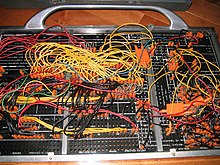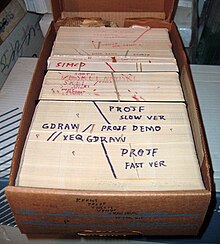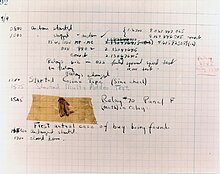Computer programming
| Part of a series on |
| Software development |
|---|
Computer programming (often shortened to programming or coding) is the process of designing, writing, testing, debugging, and maintaining the source code of computer programs. This source code is written in a programming language. The purpose of programming is to create a program that exhibits a certain desired behavior. The process of writing source code often requires expertise in many different subjects, including knowledge of the application domain, specialized algorithms and formal logic.
Overview
Within software engineering, programming (the implementation) is regarded as one phase in a software development process.
There is an ongoing debate on the extent to which the writing of programs is an art, a craft or an engineering discipline.[1] In general, good programming is considered to be the measured application of all three, with the goal of producing an efficient and evolvable software solution (the criteria for "efficient" and "evolvable" vary considerably). The discipline differs from many other technical professions in that programmers, in general, do not need to be licensed or pass any standardized (or governmentally regulated) certification tests in order to call themselves "programmers" or even "software engineers." However, representing oneself as a "Professional Software Engineer" without a license from an accredited institution is illegal in many parts of the world. However, because the discipline covers many areas, which may or may not include critical applications, it is debatable whether licensing is required for the profession as a whole. In most cases, the discipline is self-governed by the entities which require the programming, and sometimes very strict environments are defined (e.g. United States Air Force use of AdaCore and security clearance).
Another ongoing debate is the extent to which the programming language used in writing computer programs affects the form that the final program takes. This debate is analogous to that surrounding the Sapir–Whorf hypothesis[2] in linguistics, which postulates that a particular spoken language's nature influences the habitual thought of its speakers. Different language patterns yield different patterns of thought. This idea challenges the possibility of representing the world perfectly with language, because it acknowledges that the mechanisms of any language condition the thoughts of its speaker community.
History

The Antikythera mechanism from ancient Greece was a calculator utilizing gears of various sizes and configuration to determine its operation,[3] which tracked the metonic cycle still used in lunar-to-solar calendars, and which is consistent for calculating the dates of the Olympiads.[4] Al-Jazari built programmable Automata in 1206. One system employed in these devices was the use of pegs and cams placed into a wooden drum at specific locations. which would sequentially trigger levers that in turn operated percussion instruments. The output of this device was a small drummer playing various rhythms and drum patterns.[5][6] The Jacquard Loom, which Joseph Marie Jacquard developed in 1801, uses a series of pasteboard cards with holes punched in them. The hole pattern represented the pattern that the loom had to follow in weaving cloth. The loom could produce entirely different weaves using different sets of cards. Charles Babbage adopted the use of punched cards around 1830 to control his Analytical Engine. The synthesis of numerical calculation, predetermined operation and output, along with a way to organize and input instructions in a manner relatively easy for humans to conceive and produce, led to the modern development of computer programming. Development of computer programming accelerated through the Industrial Revolution.
In the late 1880s, Herman Hollerith invented the recording of data on a medium that could then be read by a machine. Prior uses of machine readable media, above, had been for control, not data. "After some initial trials with paper tape, he settled on punched cards..."[7] To process these punched cards, first known as "Hollerith cards" he invented the tabulator, and the keypunch machines. These three inventions were the foundation of the modern information processing industry. In 1896 he founded the Tabulating Machine Company (which later became the core of IBM). The addition of a control panel (plugboard) to his 1906 Type I Tabulator allowed it to do different jobs without having to be physically rebuilt. By the late 1940s, there were a variety of control panel programmable machines, called unit record equipment, to perform data-processing tasks.

The invention of the von Neumann architecture allowed computer programs to be stored in computer memory. Early programs had to be painstakingly crafted using the instructions (elementary operations) of the particular machine, often in binary notation. Every model of computer would likely use different instructions (machine language) to do the same task. Later, assembly languages were developed that let the programmer specify each instruction in a text format, entering abbreviations for each operation code instead of a number and specifying addresses in symbolic form (e.g., ADD X, TOTAL). Entering a program in assembly language is usually more convenient, faster, and less prone to human error than using machine language, but because an assembly language is little more than a different notation for a machine language, any two machines with different instruction sets also have different assembly languages.
In 1954, FORTRAN was invented; it was the first high level programming language to have a functional implementation, as opposed to just a design on paper.[8][9] (A high-level language is, in very general terms, any programming language that allows the programmer to write programs in terms that are more abstract than assembly language instructions, i.e. at a level of abstraction "higher" than that of an assembly language.) It allowed programmers to specify calculations by entering a formula directly (e.g. Y = X*2 + 5*X + 9). The program text, or source, is converted into machine instructions using a special program called a compiler, which translates the FORTRAN program into machine language. In fact, the name FORTRAN stands for "Formula Translation". Many other languages were developed, including some for commercial programming, such as COBOL. Programs were mostly still entered using punched cards or paper tape. (See computer programming in the punch card era). By the late 1960s, data storage devices and computer terminals became inexpensive enough that programs could be created by typing directly into the computers. Text editors were developed that allowed changes and corrections to be made much more easily than with punched cards. (Usually, an error in punching a card meant that the card had to be discarded and a new one punched to replace it.)
As time has progressed, computers have made giant leaps in the area of processing power. This has brought about newer programming languages that are more abstracted from the underlying hardware. Although these high-level languages usually incur greater overhead, the increase in speed of modern computers has made the use of these languages much more practical than in the past. These increasingly abstracted languages typically are easier to learn and allow the programmer to develop applications much more efficiently and with less source code. However, high-level languages are still impractical for a few programs, such as those where low-level hardware control is necessary or where maximum processing speed is vital.
Throughout the second half of the twentieth century, programming was an attractive career in most developed countries. Some forms of programming have been increasingly subject to offshore outsourcing (importing software and services from other countries, usually at a lower wage), making programming career decisions in developed countries more complicated, while increasing economic opportunities in less developed areas. It is unclear how far this trend will continue and how deeply it will impact programmer wages and opportunities. [citation needed]
Modern programming
This section relies largely or entirely on a single source. (August 2010) |
Quality requirements
Whatever the approach to software development may be, the final program must satisfy some fundamental properties. The following properties are among the most relevant:
- Efficiency/performance: the amount of system resources a program consumes (processor time, memory space, slow devices such as disks, network bandwidth and to some extent even user interaction): the less, the better. This also includes correct disposal of some resources, such as cleaning up temporary files and lack of memory leaks.
- Reliability: how often the results of a program are correct. This depends on conceptual correctness of algorithms, and minimization of programming mistakes, such as mistakes in resource management (e.g., buffer overflows and race conditions) and logic errors (such as division by zero or off-by-one errors).
- Robustness: how well a program anticipates problems not due to programmer error. This includes situations such as incorrect, inappropriate or corrupt data, unavailability of needed resources such as memory, operating system services and network connections, and user error.
- Usability: the ergonomics of a program: the ease with which a person can use the program for its intended purpose, or in some cases even unanticipated purposes. Such issues can make or break its success even regardless of other issues. This involves a wide range of textual, graphical and sometimes hardware elements that improve the clarity, intuitiveness, cohesiveness and completeness of a program's user interface.
- Portability: the range of computer hardware and operating system platforms on which the source code of a program can be compiled/interpreted and run. This depends on differences in the programming facilities provided by the different platforms, including hardware and operating system resources, expected behaviour of the hardware and operating system, and availability of platform specific compilers (and sometimes libraries) for the language of the source code.
- Maintainability: the ease with which a program can be modified by its present or future developers in order to make improvements or customizations, fix bugs and security holes, or adapt it to new environments. Good practices during initial development make the difference in this regard. This quality may not be directly apparent to the end user but it can significantly affect the fate of a program over the long term.
Readability of source code
In computer programming, readability refers to the ease with which a human reader can comprehend the purpose, control flow, and operation of source code. It affects the aspects of quality above, including portability, usability and most importantly maintainability.
Readability is important because programmers spend the majority of their time reading, trying to understand and modifying existing source code, rather than writing new source code. Unreadable code often leads to bugs, inefficiencies, and duplicated code. A study[10] found that a few simple readability transformations made code shorter and drastically reduced the time to understand it.
Following a consistent programming style often helps readability. However, readability is more than just programming style. Many factors, having little or nothing to do with the ability of the computer to efficiently compile and execute the code, contribute to readability.[11] Some of these factors include:
- Different indentation styles (whitespace)
- Comments
- Decomposition
- Naming conventions for objects (such as variables, classes, procedures, etc.)
Algorithmic complexity
The academic field and the engineering practice of computer programming are both largely concerned with discovering and implementing the most efficient algorithms for a given class of problem. For this purpose, algorithms are classified into orders using so-called Big O notation, O(n), which expresses resource use, such as execution time or memory consumption, in terms of the size of an input. Expert programmers are familiar with a variety of well-established algorithms and their respective complexities and use this knowledge to choose algorithms that are best suited to the circumstances.
Methodologies
The first step in most formal software development projects is requirements analysis, followed by testing to determine value modeling, implementation, and failure elimination (debugging). There exist a lot of differing approaches for each of those tasks. One approach popular for requirements analysis is Use Case analysis. Nowadays many programmers use forms of Agile software development where the various stages of formal software development are more integrated together into short cycles that take a few weeks rather than years. There are many approaches to the Software development process.
Popular modeling techniques include Object-Oriented Analysis and Design (OOAD) and Model-Driven Architecture (MDA). The Unified Modeling Language (UML) is a notation used for both the OOAD and MDA.
A similar technique used for database design is Entity-Relationship Modeling (ER Modeling).
Implementation techniques include imperative languages (object-oriented or procedural), functional languages, and logic languages.
Measuring language usage
It is very difficult to determine what are the most popular of modern programming languages. Some languages are very popular for particular kinds of applications (e.g., COBOL is still strong in the corporate data center, often on large mainframes, FORTRAN in engineering applications, scripting languages in web development, and C in embedded applications), while some languages are regularly used to write many different kinds of applications. Also many applications use a mix of several languages in their construction and use.
Methods of measuring programming language popularity include: counting the number of job advertisements that mention the language,[12] the number of books teaching the language that are sold (this overestimates the importance of newer languages), and estimates of the number of existing lines of code written in the language (this underestimates the number of users of business languages such as COBOL).
Debugging

Debugging is a very important task in the software development process, because an incorrect program can have significant consequences for its users. Some languages are more prone to some kinds of faults because their specification does not require compilers to perform as much checking as other languages. Use of a static code analysis tool can help detect some possible problems.
Debugging is often done with IDEs like Eclipse, Kdevelop, NetBeans, Code::Blocks, and Visual Studio. Standalone debuggers like gdb are also used, and these often provide less of a visual environment, usually using a command line.
Programming languages
Different programming languages support different styles of programming (called programming paradigms). The choice of language used is subject to many considerations, such as company policy, suitability to task, availability of third-party packages, or individual preference. Ideally, the programming language best suited for the task at hand will be selected. Trade-offs from this ideal involve finding enough programmers who know the language to build a team, the availability of compilers for that language, and the efficiency with which programs written in a given language execute. Languages form an approximate spectrum from "low-level" to "high-level"; "low-level" languages are typically more machine-oriented and faster to execute, whereas "high-level" languages are more abstract and easier to use but execute less quickly. It is usually easier to code in "high-level" languages than in "low-level" ones.
Allen Downey, in his book How To Think Like A Computer Scientist, writes:
- The details look different in different languages, but a few basic instructions appear in just about every language:
- input: Get data from the keyboard, a file, or some other device.
- output: Display data on the screen or send data to a file or other device.
- arithmetic: Perform basic arithmetical operations like addition and multiplication.
- conditional execution: Check for certain conditions and execute the appropriate sequence of statements.
- repetition: Perform some action repeatedly, usually with some variation.
Many computer languages provide a mechanism to call functions provided by libraries such as in a .so. Provided the functions in a library follow the appropriate run time conventions (e.g., method of passing arguments), then these functions may be written in any other language.
Programmers
Computer programmers are those who write computer software. Their jobs usually involve:
- Coding
- Compilation
- Debugging
- Documentation
- Integration
- Maintenance
- Requirements analysis
- Software architecture
- Software testing
- Specification
See also
- ACCU
- Association for Computing Machinery
- Computer programming in the punch card era
- Hello world program
- List of basic computer programming topics
- List of computer programming topics
- Programming paradigms
- Software engineering
- The Art of Computer Programming
References
- ^ Paul Graham (2003). "Hackers and Painters". Retrieved 2006-08-22.
{{cite journal}}: Cite journal requires|journal=(help) - ^ Kenneth E. Iverson, the originator of the APL programming language, believed that the Sapir–Whorf hypothesis applied to computer languages (without actually mentioning the hypothesis by name). His Turing award lecture, "Notation as a tool of thought", was devoted to this theme, arguing that more powerful notations aided thinking about computer algorithms. Iverson K.E.,"Notation as a tool of thought", Communications of the ACM, 23: 444-465 (August 1980).
- ^ "Ancient Greek Computer's Inner Workings Deciphered". National Geographic News. November 29, 2006.
- ^ Freeth, Tony (July 31, 2008). "Calendars with Olympiad display and eclipse prediction on the Antikythera Mechanism". Nature. 454 (7204): 614–617. doi:10.1038/nature07130. PMID 18668103.
{{cite journal}}: Unknown parameter|coauthors=ignored (|author=suggested) (help) - ^ A 13th Century Programmable Robot[dead link], University of Sheffield
- ^ Fowler, Charles B. (October 1967). "The Museum of Music: A History of Mechanical Instruments". Music Educators Journal. 54 (2). Music Educators Journal, Vol. 54, No. 2: 45–49. doi:10.2307/3391092.
- ^ "Columbia University Computing History - Herman Hollerith". Columbia.edu. Retrieved 2010-04-25.
- ^ 12:10 p.m. ET (2007-03-20). "Fortran creator John Backus dies - Tech and gadgets- msnbc.com". MSNBC. Retrieved 2010-04-25.
{{cite web}}: CS1 maint: numeric names: authors list (link) - ^ "CSC-302 99S : Class 02: A Brief History of Programming Languages". Math.grin.edu. Retrieved 2010-04-25.
- ^ James L. Elshoff , Michael Marcotty, Improving computer program readability to aid modification, Communications of the ACM, v.25 n.8, p.512-521, Aug 1982.
- ^ Multiple (wiki). "Readability". Docforge. Retrieved 2010-01-30.
- ^ Survey of Job advertisements mentioning a given language>
Further reading
- Weinberg, Gerald M., The Psychology of Computer Programming, New York: Van Nostrand Reinhold, 1971
External links
- Programming Wikia
- How to Think Like a Computer Scientist - by Jeffrey Elkner, Allen B. Downey and Chris Meyers
